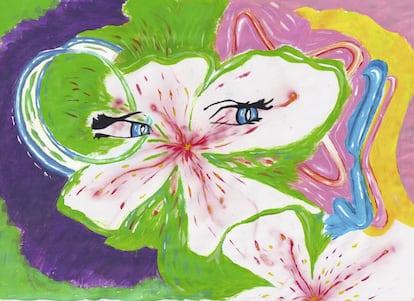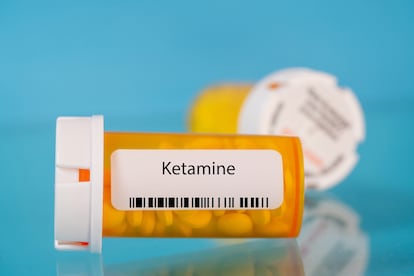What’s behind ketamine, the drug of the decade
Consumption of this substance has reached its highest point since 2017 and is leaving a mark on popular culture. Some defend its therapeutic power, but others warn of its destructive potential

It’s Saturday night and Partiboi69 is playing in a nightclub in the center of Madrid. Guests dance in an illuminated area near the DJ. The most seasoned partygoers stay behind in the dark. They are between 25 and 30 years old. They wear sunglasses. To get high, they mix a concoction that includes a stimulant such as cocaine or speed, pills or MDMA. For the last part of the night, they take ketamine.
Partiboi69 has dedicated a song, K On My D+C, to this substance, also called k, keta or special K. Although consumption is not massive, it could be at an all-time high: a few months ago, the Journal of Psychopharmacology revealed that 11% of the world’s population has tried the drug. In the United States, seizures of ketamine have increased by 349% since 2017.
It is the favorite drug of 27-year-old Gabi, who attended the party. She is a chemist and has a stable job. Before going to sleep she usually smokes a joint, and a couple of times a month she goes out to party and takes some pills. She tried ketamine about a year ago in a hotel room with her ex-boyfriend. “It was spectacular, like rising to a state of absolute peace. There was nothing in my head. Everything was super sensitive, super cool.” She took it several consecutive weekends, always in intimate and closed spaces. “In one of those there was a little left over and I took it home. And one day when I was alone I opened the balcony of my room, put on some music and took some keta.”
Ketamine belongs to the arylcyclohexylamine family of drugs, which includes phencyclidine (PCP), marketed in 1957 under the name Sernyl as a hospital anesthetic, and was withdrawn due to its strong side effects and addictive potential. In search of a safer substitute with greater medical utility, chemist Calvin Stevens synthesized ketamine in 1962. Two years later it was administered to humans for the first time, and in 1970 the Food and Drug Administration (FDA) approved its medical and veterinary use.

Today it is used throughout the world as a safe and effective anesthetic. Unlike other sedatives, it minimally affects respiratory functions. Its versatility is particularly valuable in resource-limited environments such as war zones, because it does not require advanced equipment to monitor vital functions and can be administered in different ways. It induces sedation very differently from other anesthetics. “Technically it is defined as dissociative anesthesia, because the person does not fall asleep, but rather disconnects from their body and their environment. Patients may appear conscious and have their eyes open, but they are disconnected from their environment and do not respond to pain,” describes Eduardo Hidalgo, author of a book on the subject.
What makes this substance unique is its wide spectrum of effects, which vary significantly depending on the dose administered. High amounts induce the anesthetic effects already described. Intermediate measures trigger intense visionary experiences, lasting between one and two hours. These psychedelic effects range from the sublime to the terrifying, and have an unparalleled capacity to bring about what some psychonauts have called “the journey of the little death.” “Other psychedelics make you imagine a gnome sitting on the television. With ketamine, reality as such disappears, forcing the brain to create a new one. You come to believe that what you see is real,” describes Hidalgo. Timothy Leary, famous for his research on LSD and psilocybin mushrooms, considered it the most powerful psychedelic next to salvinorin. In his book The Scientist: A Novel Autobiography (1978), the neuroscientist John Lilly, a pioneer in the use of isolation tanks and sensory deprivation, thus recounted his experience with a dose of 150 milligrams intramuscularly: “I, as an individual, disappeared.”
Recreational users like Gabi do not seek to achieve anesthetic or psychedelic states, but simply to escape: “I come from a fairly strong episode of anxiety and depression. Generally what I look for in drugs is for them to dissociate me. When I took ketamine for the first time I didn’t know where I was, but I knew I was very comfortable,” she says. Snorted in low doses, it acts as a stimulant that causes moderate perceptual distortions and incoordination, but still allows walking, dancing and talking with some ease. “It produces effects very similar to those of alcohol. The person can perceive it with a certain stimulation, and the sensation of being high,” says Claudio Vidal, state director of Energy Control. “Substances that have the potential to gain popularity are often compatible with other activities. In this case, a low dose of ketamine allows the person to maintain contact with reality and keep their feet on the ground, instead of being left lying in the corner of a nightclub.”
In the sixties and seventies, only a small group of psychedelic initiates consumed the substance. With the emergence of techno culture, its recreational use became popular. The epicenter was on the beaches of Goa, a former Portuguese colony in western India, still an important place in world psychedelic and trance culture. In 1999, the United States classified it as a Schedule III controlled substance, which authorizes its medical uses but penalizes illicit sale and possession with prison sentences. Since then, it has spread to all continents as an illegal drug.

There are several risks associated with ketamine use. One of the most common is experiencing an unanticipated psychedelic state. “It is common for panic attacks to arise, because the person begins to detect unexpected and unknown effects.” This state is popularly called a k-hole, an experience that Gabi experienced after using ketamine regularly for some time. “At first, with the first bump, I was high all afternoon. A month and a half later I was already taking 8, 10 or 14 lines. There came a point where I liked it so much that I didn’t want it to go down and I would take another one.” What began as a low dose evolved into an amount that produced an intense dissociative state. “One day I felt like my chest was crushing, like I couldn’t breathe. I felt like the couch was dragging me down and I saw a dark tunnel. It was literally the fucking M-30 tunnel [a motorway that circles Madrid] but without cars. I thought that I wasn’t breathing, but I was breathing perfectly. Luckily my ex-boyfriend helped me recover little by little, but for me that lasted an eternity.”
Although ketamine has a lower addictive potential than substances such as cocaine, morphine or heroin, it has been shown to produce rapid tolerance and can lead to severe addiction. With continued use the consumer must increase the dose to achieve the same effect. “It is important not to be fooled by the fact that ketamine has psychedelic properties and, in general, these types of substances do not cause dependence. It is more than proven that a percentage (perhaps around 10-15%) of habitual users end up meeting the diagnostic criteria for addiction,” explains Eduardo Hidalgo in his book on the substance. One of the most common side effects of prolonged use and high doses of ketamine is interstitial cystitis or hemorrhagic cystitis. This condition is characterized by inflammation of the bladder, which can lead to symptoms such as pain when urinating, urgent and frequent need to urinate, blood in the urine. In severe cases, it can result in irreversible damage to the bladder requiring its removal.
Ketamine has shown promise in cases of treatment-resistant depression, particularly those that do not respond to conventional antidepressants. Rupert McShane, professor of psychiatry at the University of Oxford and director of the ECT and ketamine studies in Oxfordshire, sees a great future for this treatment. “I’m completely sure,” he says. “It surprises me that people are reluctant to acknowledge the evidence. There are hundreds of randomized controlled trials supporting its benefits, in both short- and long-term research. I consider myself fortunate to have been at the forefront of a breakthrough that will clearly have a significant therapeutic impact.”
Unlike traditional antidepressants, which can take weeks to show effects, ketamine works quickly, often within hours or days. This rapid antidepressant effect is particularly valuable for patients with suicidal thoughts, where rapid treatment is essential. “Depression is like a constant brake on our mind, which hinders the flow of thoughts and emotions. It’s like driving with the handbrake on: you move forward, but it’s difficult. Ketamine works by releasing that brake, allowing you to think clearly and feel more energy and motivation,” says McShane. He adds that it is a shame that the use of ketamine is not more common in the clinic. “Two recent investigations show that it is as effective as ECT (which induces electrical seizures in anesthetized patients) but with fewer side effects. Ketamine could be an option instead of ECT.”
A recent article published in The Face magazine identified ketamine as the drug of this decade. “Throughout history, certain substances have symbolized specific periods, and have reflected the trends and social and cultural contexts of those times,” explains José Carlos Bousó, scientific director of Iceers, an institution based in Barcelona dedicated to the study of psychoactive plants. “During the sixties, LSD left an indelible mark on music, and influenced great rock bands such as the Beatles, Jimi Hendrix and the Rolling Stones. I could say the same about MDMA and electronic music in the eighties and nineties.”
Although it has already been mentioned in songs like Lost in the K-hole by The Chemical Brothers and Special-K by Placebo, this white-looking powder, slightly more crystalline than cocaine, is increasingly present in contemporary culture. Elon Musk, owner of X and co-founder of Tesla, has admitted on several occasions to consuming this substance in small doses. A Rolling Stone article from earlier this year asked if the queer community had a problem with ketamine. Brutalismus 3000′s debut album, Ultrakunst, eleventh on the German chart in April, also makes reference to this drug. In the world of television, ketamine has been seen in series such as The White Lotus, Industry and The Night Of. In the recent Rotting in the Sun, starring Instagram celebrity Jordan Firstman, a character claims, “All gay men take ketamine.”
K has become part of nightlife’s urban legends. When leaving the club, a group of young people deliberates about where to go for an after-party: a house or a dark club. They opt for the latter. On the way to the club in question, someone tells one of those anecdotes that only happen to “a friend” or “a friend of a friend”: “The police stopped them in the car and took their keta, and they left them waiting inside. After a while, they came back and asked them what the hell they had taken from them. They had taken it thinking it was coke, and now they had to drive.”
Sign up for our weekly newsletter to get more English-language news coverage from EL PAÍS USA Edition
Tu suscripción se está usando en otro dispositivo
¿Quieres añadir otro usuario a tu suscripción?
Si continúas leyendo en este dispositivo, no se podrá leer en el otro.
FlechaTu suscripción se está usando en otro dispositivo y solo puedes acceder a EL PAÍS desde un dispositivo a la vez.
Si quieres compartir tu cuenta, cambia tu suscripción a la modalidad Premium, así podrás añadir otro usuario. Cada uno accederá con su propia cuenta de email, lo que os permitirá personalizar vuestra experiencia en EL PAÍS.
¿Tienes una suscripción de empresa? Accede aquí para contratar más cuentas.
En el caso de no saber quién está usando tu cuenta, te recomendamos cambiar tu contraseña aquí.
Si decides continuar compartiendo tu cuenta, este mensaje se mostrará en tu dispositivo y en el de la otra persona que está usando tu cuenta de forma indefinida, afectando a tu experiencia de lectura. Puedes consultar aquí los términos y condiciones de la suscripción digital.
More information
Últimas noticias
Maduro pleads not guilty before the federal court in New York: ‘I am still the president of Venezuela’
A new test can detect Alzheimer’s from a finger prick
UN team enters Sudanese city of El Fasher after paramilitary massacre: ‘It’s like a ghost town’
A recipe for resistance: Indigenous peoples politicize their struggles from the kitchen
Most viewed
- Gilles Lipovetsky: ‘If you want to live better and fall in love, take Prozac, don’t look to philosophy’
- Alain Aspect, Nobel laureate in physics: ‘Einstein was so smart that he would have had to recognize quantum entanglement’
- Alvin Hellerstein, a 92-year-old judge appointed by Bill Clinton, to preside over Maduro’s trial in New York
- Why oil has been at the center of Venezuela-US conflicts for decades
- Maduro’s downfall puts China’s relationship with Venezuela to the test










































